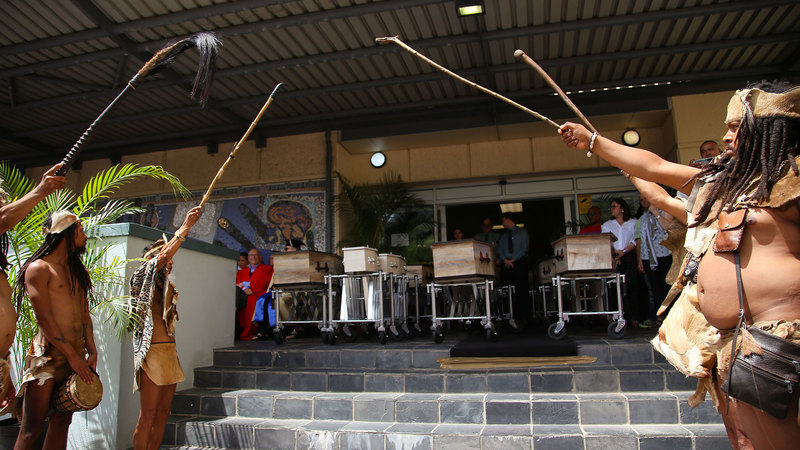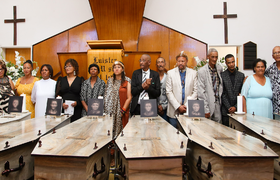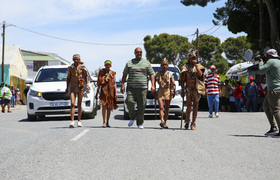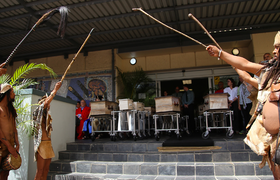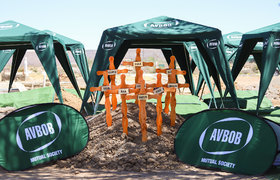Poignant moment as Sutherland Nine make final journey home
28 November 2023 | Story Niémah Davids. Photos Je’nine May. Read time 7 min.The end of life of the Sutherland Nine, more than a century ago, was marred by disregard, violation, injustice and pain. But as their coffins were carried from the University of Cape Town’s (UCT) Anatomy Building to begin their final journey home, a sense of peace and gratitude prevailed for those whose lives were touched by this unspeakable tragedy and for the ties that bind them.
The world was a different place in the early 1920s when UCT committed one of the worst atrocities of its time and callously acquired and accepted the sacred skeletal remains of the nine individuals for teaching and learning, and research purposes.
Carel Gert Coetzee from the Kruisrivier Farm near Sutherland – a UCT medical student between 1925 and 1931, and his father – the owner of the land, committed the unthinkable when they removed the nine skeletons from their graves, located in the farm’s cemetery and on its hills, and donated them to UCT’s medical school. Records indicate that the Sutherland Nine had been captured and forced into indentured labour on the farm and suffered in death a similar painful fate.
Historic moment
It’s been six years since an archiving audit, led by UCT’s curator of human remains, Associate Professor Victoria Gibbon, uncovered the truth. And after a long, winding road, which started with establishing a multidisciplinary team of academics to contribute to the project and piece together answers to important questions about the individuals (like what they looked like and their preferred diets), the university bid the Sutherland Nine a sombre farewell on Friday, 24 November.
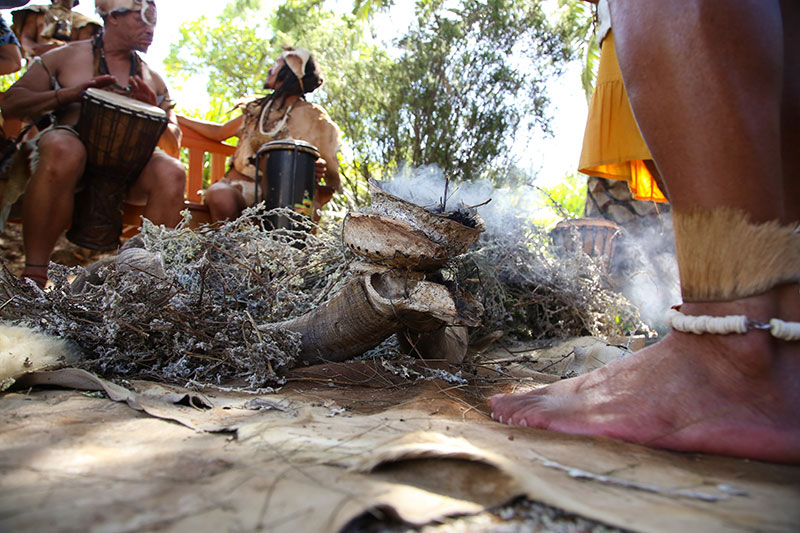
The sendoff, hosted by UCT Vice-Chancellor interim Emeritus Professor Daya Reddy included significant spiritual, cultural and historical rituals, an unveiling of a garden of remembrance as a tribute to the nine individuals, as well as a naming and private wrapping of the sacred remains. It kicked off the three-day repatriation process that ended with a special reburial ceremony in Sutherland on Sunday, 26 November.
“We recognise these ancestors amongst us because no student, no scholar in this place can ever deny again that they were a part of our learning.”
In preparation for their journey to their final resting place, nine coffins, including those of two children, were lifted into their hearses and slowly made their way off the Faculty of Health Sciences (FHS) campus precinct as academics and students formed a guard of honour as a sign of respect – marking a poignant, reflective moment etched into UCT’s history.
‘Forever a part of our story’
In welcoming the audience that comprised various delegates and direct descendants of the Sutherland Nine, Professor Lionel Green-Thompson, the FHS dean, said the individuals will forever be a part of the faculty’s and the university’s story, and can no longer be erased.
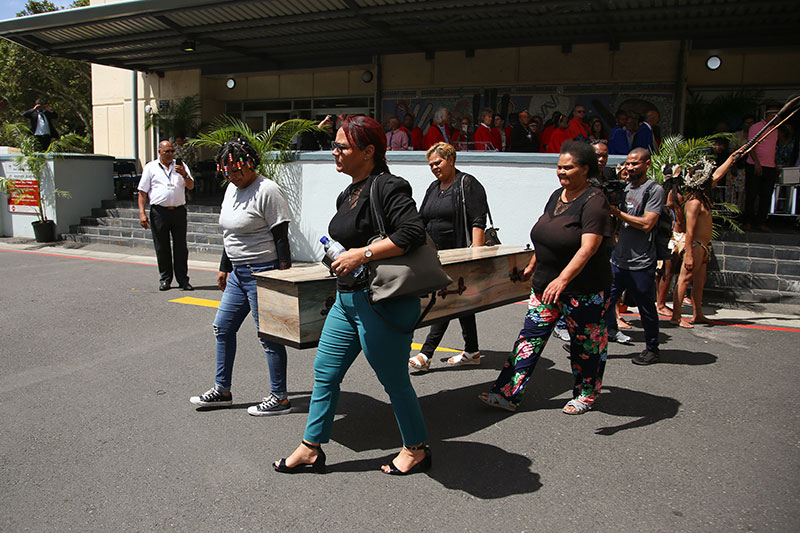
“We recognise these ancestors amongst us because no student, no scholar in this place can ever deny again that they were a part of our learning. They are an integral part of the story that we wish to tell. We can’t say we don’t know them. We must name them when we speak about the history of this faculty because we’ll always be reminded that they are part of our story and that can never be taken away from them and from us,” Professor Green-Thompson said.
He extended a warm welcome to the families, who he described as a living reflection of who the nine individuals were. He told them: “You too are a part of us” and encouraged them to remember that long after the Sutherland Nine have been laid to rest.
Creating a path for redress, restorative justice
That means to never forget the injustice they had endured and to share their story. Their fate is a distressing chapter in UCT’s history, said Emeritus Professor Reddy. He described the acquisition as an act of disconnecting members of a family and community from their home and from each other. It was also a blatant refusal to see these individuals as fellow human beings.
However, since 2017, the university committed to correcting its wrongs through a process of redress and restorative justice. This process, Reddy said, involved establishing the genders of each individual, which are four men, two women and two children. The nineth skeleton is that of an unknown individual found in Sutherland. Most of the adults died between 1875 and 1890, while the children died before 1880. The skeletons were connected to the Stuurman and Abraham families, who now live in the Eastern Cape, Northern Cape and Western Cape.
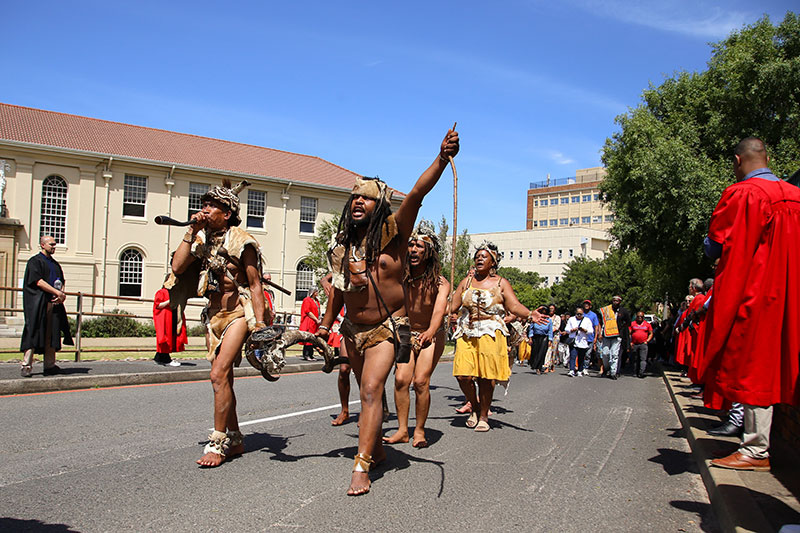
“Today, we have a scientific, historical and social overview of who these nine people were. They have shared their humility with us. They live on, not just through their descendants but through the impact they have made on UCT and South Africa. Their lives have touched ours and they have honoured us across the decades.
There’s a bigger story to tell
When the family first received word about the Sutherland Nine in 2018, they felt the spirit of their ancestors. One of the family spokespersons, Anthony Stuurman Mietas, said the tragedy connected family members, who, under normal circumstances, would probably never have met. But the reunion was a sad one and forced them to have difficult, complex conversations about what the repatriation process would entail. More than that, he said, it offered an opportunity to engage with the elders and gain insight on some of the injustices of the past, which they often find very difficult to discuss.
“We could see traces of their legacy – in the mountains, in the fields and in the oral history around us.”
“This served as a brutal reminder that even though we knew we had our ancestors there at one point in time, even though they were written out of the history books, we could see traces of their legacy – in the mountains, in the fields and in the oral history around us,” Stuurman Mietas said.
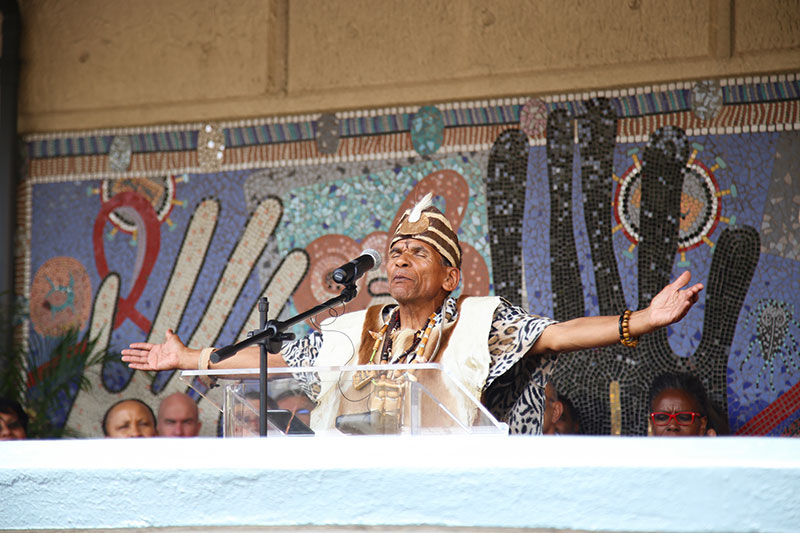
Sadly, he said, the story of the Sutherland Nine is not unique, and as a result, the Stuurman and Abraham families are hoping to use the tragedy to become a voice for repatriation of other sacred remains to ensure that they are returned to the land where they came from.
“We are proud to become a voice for repatriation. We are proud to say that even though this was difficult, we realise that our story is not unique in South Africa. There is a bigger story to tell,” he said. “These sacred human remains will always be a beacon on hope for the hopeless; it will become a pillar of strength in my community; it will foster relations between the oppressed and the oppressor of the past; and it will break down stereotypes. It will [make] my community members [proud] to walk the land they occupy and feel like they belong.”
‘Your work is done’
Reflecting on the multi-year process, Associate Professor Gibbons described it as an “interconnection and interwoven fabric that has come to be the people in this room and the people in this process”. She said the nine individuals have woven together this fabric, which also contains snags and holes. But despite those holes, she said, role-players always managed to find ways around them.
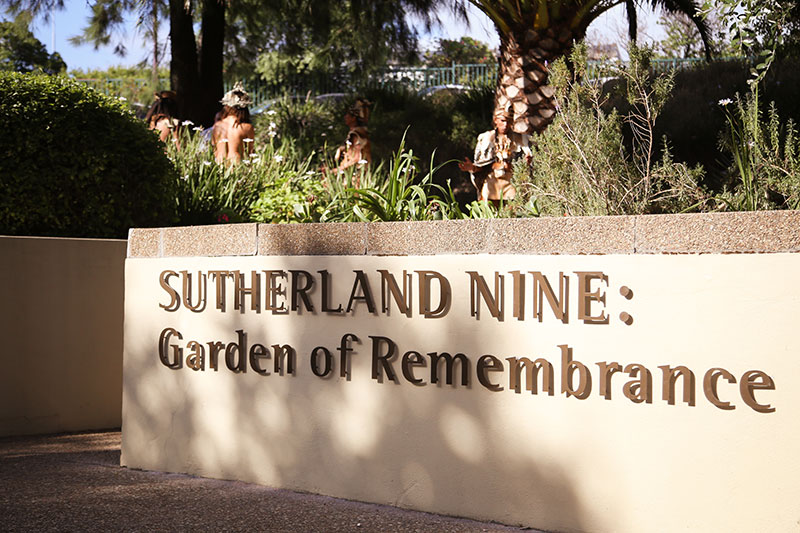
Her message to the Sutherland Nine was a powerful one: “I want to say to the Sutherland Nine that your work is done. You can rest now.”
“When I look [at] this fabric, it’s complex and it’s bright – a lot of colours, intricate weaving. No matter where we are now, it is because of the Sutherland Nine,” she said. “When we were blind, you helped us see; when we needed guidance, you navigated for us; and when we went too quickly, you slowed us down. You have changed national policy; you’ve changed us. You can rest now. You’ve connected the past, the present and the future and now you can rest. We send you home today.”
The day’s programme was officiated by Professor Tracy Naledi, the deputy dean for social accountability and health systems in the FHS.
Part of the Department of Human Biology’s commitment to redress and restorative justice is to remove the names of all those responsible for the Sutherland Nine tragedy from all visible aspects of the building.
Others who contributed to this event included Dr Nomafrench Mbombo, MEC for Health in the Western Cape; Gillian Peters, speaker of the Namakwa District Municipality; and Desery Fienies, MEC for Sport, Arts and Culture in the Northern Cape who represented Zamani Saul, the premier of the province.
 This work is licensed under a Creative Commons Attribution-NoDerivatives 4.0 International License.
This work is licensed under a Creative Commons Attribution-NoDerivatives 4.0 International License.
Please view the republishing articles page for more information.


